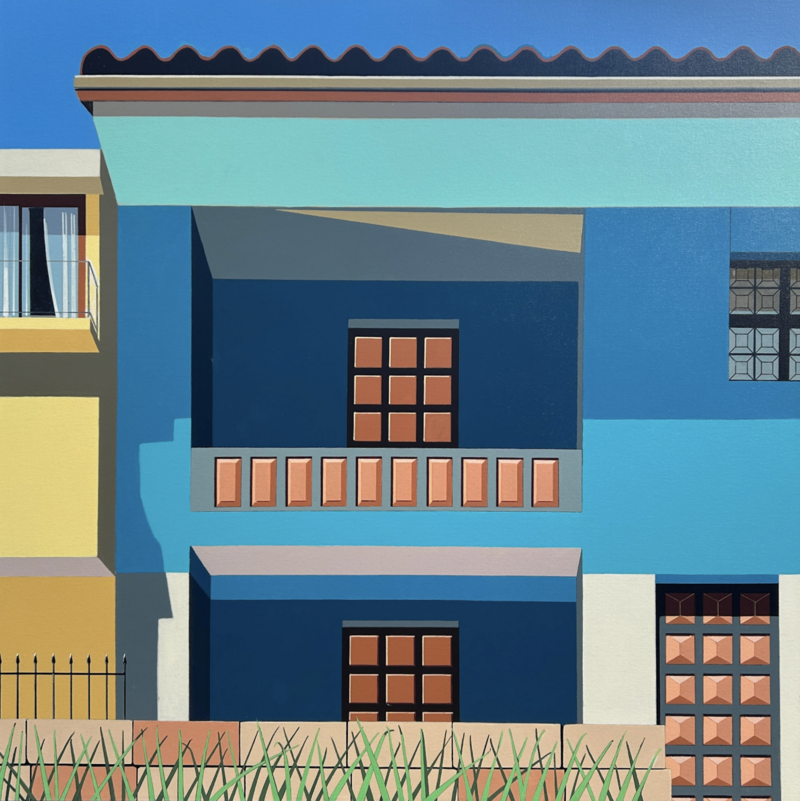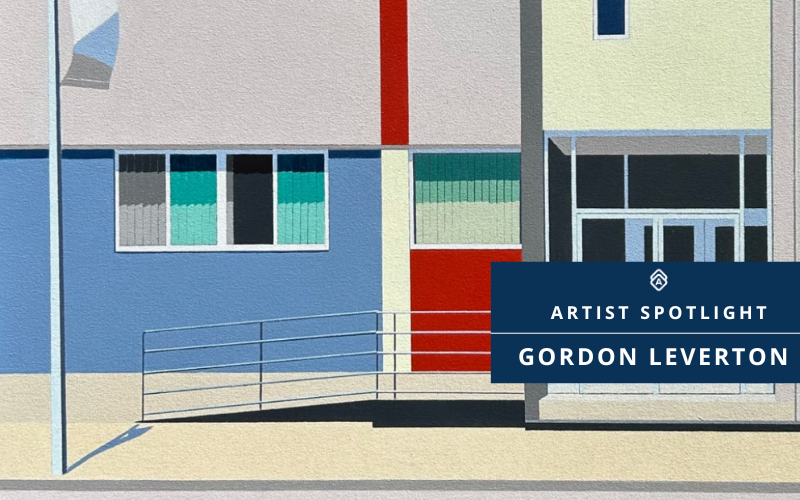
Gordon Leverton, Accordance, 24 x 36 x 1.5 in
The subject might be a street corner, but the impulse behind it is human connection.
With no formal art training, self-taught Featured Artist Gordon Leverton turned to the city around him for inspiration: rooftops, alleyways, and side streets.
He began breaking the built environment into planes of color, light, and shadow, transforming the everyday into bold, graphic compositions that carry his unmistakable voice. Leverton's pieces are recognizable at a glance: striking geometry, vibrant palettes, and shadows that stretch across surfaces like time. By isolating structures and simplifying form, he invites viewers to see familiar spaces with fresh eyes.
His work captures not just what a city looks like, but how it feels. It’s a practice built on close observation, abstraction, and deep attention to what’s often overlooked.
Gordon Leverton is proof of what’s possible when you stay curious, keep working, and trust that your perspective matters.
Artwork Archive had the chance to chat with Gordon Leverton about his creative process, how he physically explores his subject matter, and why Artwork Archive is important to his art career.
You can see more of his work on Discovery and learn more about his art practice below:
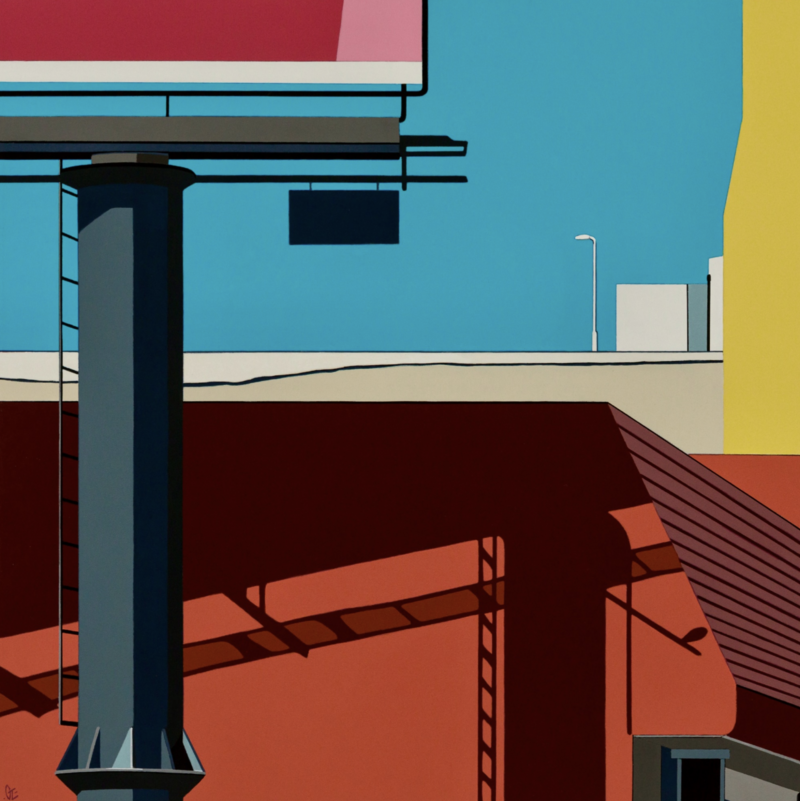
Gordon Leverton, Out of Range, 36 x 36 x 1.5 in
Gordon Leverton Looks Where Others Don’t
You won’t find grand skylines or tourist landmarks in Gordon Leverton’s paintings. He's drawn instead to the parts of a city that get skipped over: the alleys, the shadows between buildings, the unassuming corners where color and form accumulate.
“My work begins with exploring communities,” he shares. “Whether that’s in Hamilton, Ontario, where I live, in cities like Toronto, or further abroad in places like Portugal, Peru, and Mexico.”
Wandering through neighborhoods with his camera, he captures building facades, shadows, signage, and surfaces layered with time. He often returns from a trip with hundreds of reference images, which he edits down in the studio, compiling what he calls a “wish-list” of future paintings. Natural light is essential to how he captures a scene, so weather can interfere, but he leans into those constraints.
The painting process itself is meticulous. He tends to work on square canvases—30x30” or 36x36”—mapping out a precise grid before diving in with paint. “It lets me relive the moment of discovery,” the artist notes, describing that transition from reference to creation.
What began as direct representation has gradually opened up. Leverton’s more recent works introduce imagined elements—trees that weren’t there, altered shadows, borrowed architectural motifs. He isn’t aiming for exact replication, but something that captures the feeling of a place and what it held, or might have held.
Urban Landscapes as Living Systems
Leverton doesn’t see a city as a collection of separate structures. He sees it as an ecosystem.
“I’m always aware of how connected we are in cities,” he reflects. “Our network of grids is interdependent, like a forest with its underground circuits of plant roots.”
It's the quiet interconnectibity of neighbors chatting over fences, people passing one another on the street, shared routines and invisible exchanges that gives his paintings their undercurrent. The subject might be a street corner, but the impulse behind it is human connection.
“We have conscious and unconscious ways of communication,” he continues. “We are a social species, and this is what ultimately drives my work.”
Gordon Leverton, WINAY [Content], 36 x 36 x 1.5 in
A Residency in Mexico Opens the Door to Abstraction
Abstraction has long been part of Leverton’s practice, but this year, it took on a new clarity. While completing a self-directed residency in Guadalajara, the artist spent his days walking through neighborhoods and absorbing the signage, colors, and textures around him.
During those walks, a clear direction emerged. “A theme of shadow, text, and color started to show up in everything I was doing,” he remembers. He left the city for Chapala, where he set up a studio in a small casita and painted daily with birdsong drifting in through the windows. The body of work that came from this period was later shown at #Hashtag Gallery in Mexico City.
That energy carried home with him. Once back in Canada, he found himself returning to those themes—working larger, working looser, and giving the intuitive side of his practice more room to lead.
Working Through Doubt by Working Anyway
Every artist deals with it at some point. That nagging voice in your head. The feeling that you're not good enough. Self-doubt hasn’t disappeared from Gordon Leverton’s studio. It still shows up. It still asks the same tired questions. But over time, he’s figured out how to let that voice ride in the passenger seat instead of driving the car.
“I always question myself,” he acknowledges. “And I think all of us are victims of impostor syndrome at times.”
He doesn’t pretend that self-assurance is constant or that the creative process always feels sturdy. What’s changed is how he uses those feelings. That inner critic, he’s found, can actually push things forward if you don’t let it stall you out completely. For him, it comes back to presence and practice. “Be thankful for each day you can stand at the easel and create,” he adds. That simple act, done consistently, has become the most reliable way to quiet the doubt.
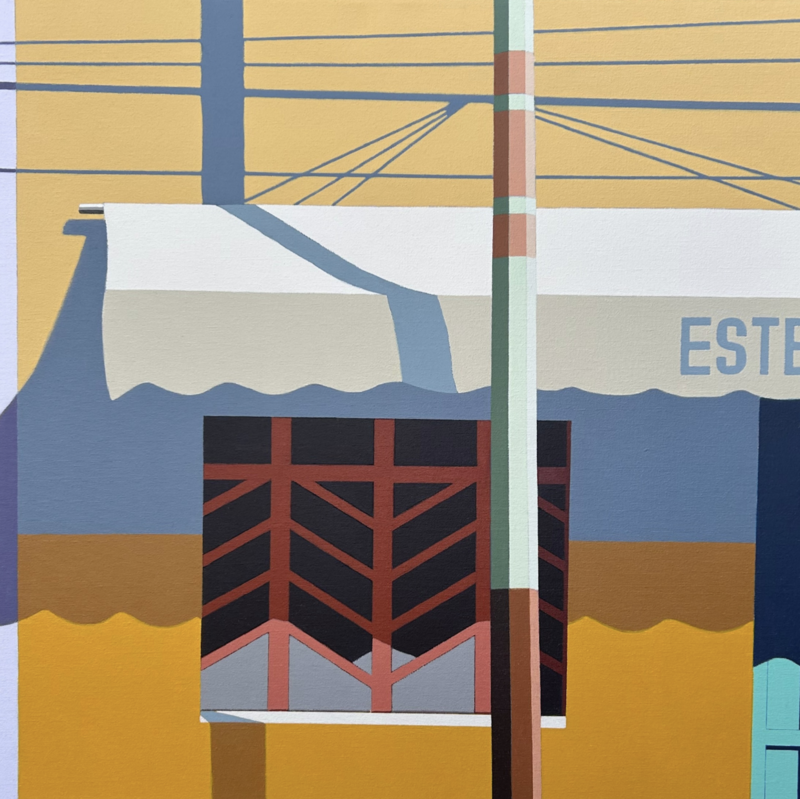
Gordon Leverton, Este, 24 x 24 x 1.5 in
Getting Serious About the Business Side of Art
Early on, Leverton realized that talent and passion alone weren’t enough to grow a sustainable practice. He needed systems. “Acknowledging that good business practices will help grow your art career—that’s the mindset shift,” he lays out plainly.
Bit by bit, he put tools in place that would help his practice run more smoothly. “I invested in having my artwork professionally photographed. I signed up for Artwork Archive for its inventory management systems. I started using tax software. I built a website and started an email list,” he recalls, almost like ticking items off a checklist.
“These practices were worth the cost,” the artist insists. “I made up for it with more time in my studio.”
Marketing, on the other hand, didn’t come as naturally. “That’s the one I had to learn the hard way,” he admits. Even now, he's still adapting, but learning how to support his art with structure turned out to be just as important as learning how to make it.
Create a System You’ll Actually Stick To:
Trying to keep track of everything in your head (or on sticky notes) only works for so long. Leverton leaned on Artwork Archive’s inventory management to get organized, but it’s not just about uploading artwork. You can log pricing history, track where a piece is showing, and even see when it sold and to whom. Once it’s in there, you’re not scrambling every time a gallery emails you.
Give it a shot: pick five pieces and fully log them—image, description, price, location, everything. See how that feels.
Why He Still Uses Artwork Archive Over a Decade Later
Organization is baked into how Gordon Leverton runs his practice. And after ten years with Artwork Archive, he doesn’t have to think twice about why he still uses it. It’s become an essential part of how he stays organized and presents himself professionally.
“I can call up literally any info I need with a couple of clicks,” he says.
When a gallery requests a selection of available work, or a collector wants more details, he doesn’t waste time pulling together a PDF or digging through his files. Instead, he opens up a Private Room, selects the artwork he wants to highlight, and sends off a clean, custom link. “I create a customized link with specific artworks and features for each situation,” he explains. “It takes less than two minutes. I can even do it on my phone.”
He also makes use of the Location feature. Since every piece is documented, he can log which show a piece has been in, what city it traveled to, and when it's expected back. “It’s so easy to keep everything straight.”
And in recent months, he’s started diving into the platform’s growing list of opportunities and Resource section, browsing calls for artists and residency listings. “There’s just so much useful information,” he concludes, still finding new corners to explore.
Dig Into the Opportunities You’ve Been Meaning to Apply For:
Even after ten years, Leverton’s still finding new things inside his Artwork Archive account. Lately, he’s been using the Resources tab to look up residencies and calls for entry.
If you’ve only ever used the platform for inventory, take five minutes, open up our Complete Guide to 2025 Artist Opportunities, and poke around. There might be something in there waiting for you.
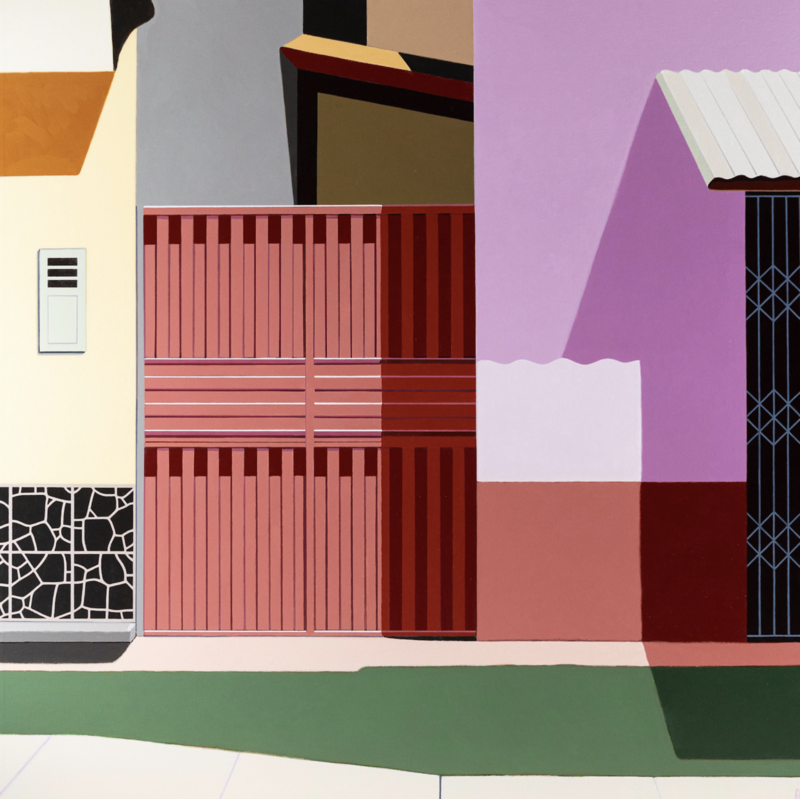
Gordon Leverton, Estructura (Structure), 36 x 36 x 1.5 in
A Seamless Sale, Thanks to Smart Organization
At a recent show opening, Gordon Leverton found himself in conversation with a longtime collector who expressed interest in a new painting. She liked the work but wanted to be sure it would pair well with a piece she had purchased from him back in the early 2000s.
Rather than make a guess or suggest she follow up later, Leverton pulled out his phone. "As part of my best practices, I regularly update the sales and client records in my Artwork Archive account," he explains. “So I was able to pull up her client profile in seconds.”
He located the earlier piece she had purchased, pulled up the image and details, and within moments, was showing her the piece she had collected years ago. Seeing both works side by side helped her make the decision. “It gave her the confidence that the two pieces would complement each other,” he points out. “Both the collector and the artist beside me were impressed by the level of professionalism and organization."
She made the purchase on the spot, and after seeing how smooth the process was, his artist colleague signed up for the platform shortly after.
Turn Collector Insights Into Your Next Move:
If you're already logging collector purchases like Leverton, take it one step further: track what types of work they're drawn to. With Artwork Archive, you can add notes to client records—whether it's what they said they’re looking for, when they last bought, or even what not to pitch them again.
Over time, you'll start seeing patterns. Maybe a certain size, palette, or subject resonates most. That kind of insight can shape what you show them next or even guide future series.
Take five minutes to revisit your last three sales. Is there a theme? Jot it down—you might be onto something.
For Emerging Artists: Get Involved, Stay Curious, Work Hard
Leverton’s advice for those just starting out is both grounded and generous.
“Only take advice from people who know what they’re talking about,” he throws out, like a rule he’s learned the hard way. “Go explore your local art community. Get your face seen. Join artist groups.”
Volunteering, he believes, is one of the best ways to build connections and momentum, even if it doesn’t immediately lead to opportunity. “That good energy will come back to you,” he offers. “And if it doesn’t, you still made a difference to someone.”
His final piece of advice comes with no qualifiers: “Work HARD and don’t give up.”
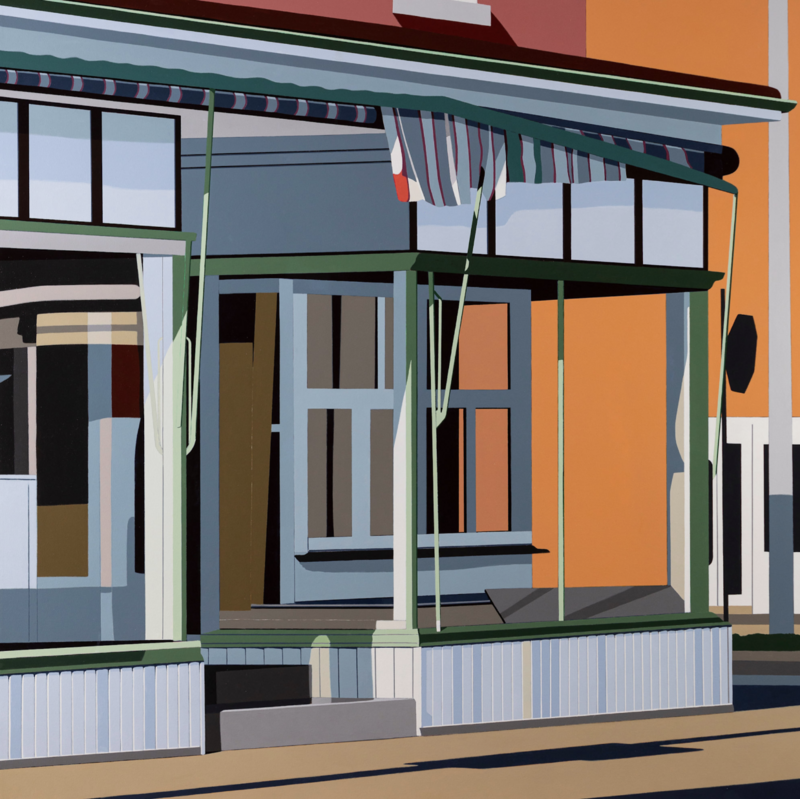
Gordon Leverton, Vintage Charm, 48 x 48 x 1.5 in
No matter where you are in your art journey, getting your business side in order doesn’t have to feel overwhelming. A bit of structure now can mean more time and headspace for the work you actually want to be doing.
Artwork Archive helps artists build an online portfolio, stay on top of their inventory, and create things like tear sheets and invoices in just a few clicks. Explore the tools and see how it fits into your own process.
